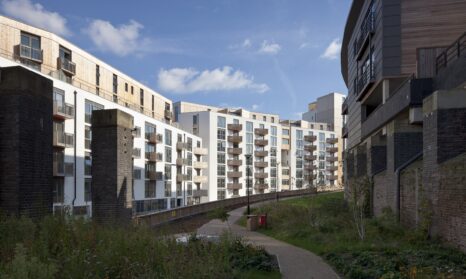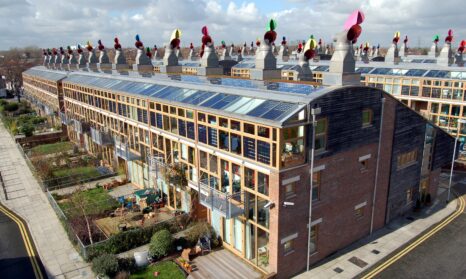Policy under the spotlight: London’s zero-carbon homes
In 2011, the UK Government announced that every new home built from 2016 would have to be ‘zero-carbon’. Last year, in an attempt to ‘speed-up’ house-building, that requirement was scrapped. See what I had to say about that decision. On a list of reasons why adequate housing is sorely lacking in this country, I’m willing to bet that the demands placed on housebuilders by energy policies would be pretty far down.
This decision is looking even more ridiculous considering that London, a city where the housing crisis is the top concern among voters, has retained this policy. Demand for housing far outstrips supply in our capital, and the new Mayor Sadiq Khan obviously doesn’t think that a blanket zero-carbon homes policy will exacerbate this situation.
Let’s not kid ourselves, zero-carbon homes are almost as hard to deliver as they are to define. Working with dedicated and imaginative developers, we at Bioregional have succeeded in building One Planet Communities that come very close to having zero-carbon emissions from their residents’ energy use for heat and power in the home.
Policy 5.2 of the London Plan states that, from 2013-2016, all residential buildings included in major developments must demonstrate a 35% improvement in energy savings achieved by the building fabric over those set out in Part L of the existing 2013 building regulations, and from October 2016, achieve ‘zero-carbon’ emissions.
Working with dedicated and imaginative developers, we at Bioregional have succeeded in building One Planet Communities that come very close to having zero-carbon emissions from their residents’ energy use for heat and power in the home.
Does this mean that, starting next month, every new London home applying for planning consent will have absolutely zero-carbon emissions associated with its operation? That its heating and power demand will be wholly minimised and satisfied completely by renewable energy?
Well, no. The Mayor’s definitions of a zero-carbon housing scheme doesn’t quite match with ours. What he is asking is that new homes still achieve a 35% improvement in energy savings and the emissions rate over Part L, but that the remaining (regulated) emissions will be offset via a payment into a ring-fenced fund, administered by individual boroughs. The Mayor works from an indicative figure of £60/tonne for 30 years, but boroughs are welcome to set their own.
This money is then used to fund specific energy efficiency projects in the borough, for example to retrofit council buildings, put photovoltaics on schools or provide loans or grants to householders or businesses for efficiency measures.
The more brown energy a housebuilder’s home consumes, the more they pay to green causes. Sounds pretty commendable right?
The problem with this model is that carbon emissions still continue with new housing development; it is only responsibility for them that is rescinded. As built environmentalists, we would be delighted to see existing homes become better insulated and public buildings run on renewable energy, but not necessarily by allowing new homes to continue to emit carbon.
At our One Brighton development, a community-owned Energy Services Company (ESCo) purchases and distributes green electricity from a renewable energy provider on behalf of residents.
And with local authorities more and more stretched, who will be certain that an energy fund will be used efficiently and effectively? As a reference, see the Green Deal; a centrally administered initiative launched to great fanfare but pulled last year after extremely limited impact.
This policy does not encourage innovative approaches to reducing carbon emissions on new developments. Although I don’t believe that it will ‘Stop Britain Building’, I do think developers will see this as another tax on their work and use it to argue that viability of projects can’t be maintained so it is zero-carbon or affordable homes, not both. We will need strong leadership from Mr Khan to see that one is not played off against the other.
Neither does this policy contribute to decarbonisation of the grid, an essential process if Britain is going to meet its 2050 carbon targets. At our One Brighton development, a community-owned Energy Services Company (ESCo) purchases and distributes green electricity from a renewable energy provider on behalf of residents. More strategy like this in new development would actively encourage mass-generation of green energy, but this is not an allowable solution to achieving zero-carbon according to the London Plan.
Ultimately however, although not perfect, this policy is an improvement on what it replaces. It could lead to important community or public energy projects being realised which otherwise wouldn’t get delivered, and also provides a solution of sorts for schemes where carbon emissions cannot be immediately addressed. It’s just a shame that new development will be able to pay to pollute, when, as we have shown in One Planet Communities across the world, most homes could achieve zero-carbon emissions if their developer showed just a little more dedication and imagination.
Learn more about how we help new-build developers embed sustainability within their exemplar schemes.







